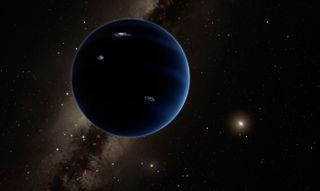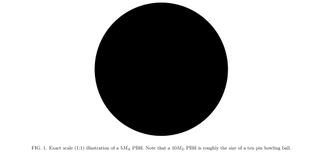Is Our Solar System's Mysterious 'Planet 9' Really a Grapefruit-Size Black Hole?
It probably isn't a black hole, if it exists at all. But two physicists think we should check to see if it's a black hole anyway.

Two physicists think that we should check to see if there's an ancient, grapefruit-size black hole hiding out in our solar system. And that tiny, heavy object might in fact take the place of a theoretical planet that some researchers think might be tugging on other objects in our solar system, the so-called Planet 9.
Does that mean there's really a black hole hiding out in our corner of space? No, the researchers said.
But they've assembled an argument for its existence that they think is compelling enough to be worth looking into.
Here's how it goes:
Far away in the outer reaches of the solar system, past where Neptune, our most distant known planet, orbits, there are a handful of small objects that behave strangely. These "trans-Nuptunian objects" (TNOs) cluster together in unusual ways, and they tend to spin around axises that point toward one broad swath of the sky, away from the larger known planets. Also, critically, the TNOs orbit in a different plane than the eight known planets. That suggests that something else is tugging on them with its gravity.
Related: The 12 Strangest Objects in the Universe
Some astronomers have looked at that strange pattern, run some calculations, and concluded that there must be another planet out there, one that’s 10 to 20 times the mass of Earth and following a wonky orbit that carries it many hundreds of times Earth's distance from the sun. It's a bizarre theory, usually called "Planet 9," but one that astronomers take seriously. The hunt for Planet 9 has gone on for years, with astronomers using visual light and infrared telescopes to scan the outermost parts of the solar system.
Sign up for the Live Science daily newsletter now
Get the world’s most fascinating discoveries delivered straight to your inbox.
"The thing that we realized is that the gravity is the important thing," said Jakub Scholtz, a physicist at Durham University in England and one of the two astronomers behind the idea. "It doesn't need to be a planet. The most mundane, or maybe the most sane explanation is that it's a planet. But as theoretical physicists, we know that early-universe cosmology can very readily introduce a range of very interesting new theoretical bodies — one of which… is primordial black holes."
Primordial black holes are different
Usually, when we talk about black holes, we mean enormous objects formed when giant stars collapse into themselves, trapping their masses in infinitely dense singularities, surrounded by giant "event horizons" from which no light can escape. But some cosmologists believe that in the first moments of the universe, when everything was hot and dense and rushing away from the Big Bang, and no stars had formed yet, black holes were already emerging.
Related: From Big Bang to Present: Snapshots of Our Universe Through Time
These primordial ghosts of the universe's creation would have formed when chunks of that early matter were crushed together so tightly that they condensed into singularities.
"That part of the universe is so dense, it just becomes a black hole," Scholtz told Live Science.
These black holes would be smaller than stellar black holes formed from collapsing massive stars, said James Unwin, a physicist at the University of Chicago and co-author of the paper. And according to some models, they'd be just a handful of times heavier than Earth.
A black hole of that mass wouldn't look like much of anything, Unwin said. Its event horizon would be tiny — about the size of a grapefruit if it's five times the mass of Earth, and the size of a bowling ball at 10 times Earth's mass. But gravity is gravity. If a PBH found its way into our solar system, that black hole would orbit the sun like a planet would, and it would tug on dwarf planets and asteroids just like the theoretical Planet 9 would. There wouldn't be any way to tell the effects of a planet's gravity from that of a primordial black hole of the same mass.

The same models that produce primordial black holes, Unwin said, also offer the best explanation for how the Higgs mechanism (thought to imbue mass on all particles) and other basic physics emerged into the universe. So there's good reason to think that these things exist, whether or not any have since ended up in our solar system or any other star system. But no one's ever actually found one.
Related: 9 Ideas About Black Holes That Will Blow Your Mind
Black holes bending light
However, there's some recent evidence to suggest that they might really exist, Unwin said.
"I think this is fairly unknown-about in the community," Unwin said, "and we're really trying to bring it to wide attention."
There's an experiment called the Optical Gravitational Lensing Experiment (OGLE) in Poland. It scans the sky for evidence of gravitational "microlensing," places in space where a planet or some other object's gravity has bent the path of a ray of light, causing it to hit Earth. In the cases of the stars studied by OGLE, this light-bending just looks like the star momentarily brightening.
But OGLE has reported something strange, they said. Six times, it has spotted very brief microlensing events, less than 0.3 days long, suggestive of very fast-moving objects between 0.5 Earth masses and 20 Earth masses zipping past stars. This isn't how planets look to OGLE, Unwin said, and there's good reason to suspect that the six objects might be primordial black holes. (Another possibility is very-fast-moving "free floating planets" moving around outside star systems, but current planetary models wouldn't predict that many such planets zooming around the universe.)
If those six objects were small, ancient black holes, Scholtz said, then that means such black holes aren't so rare in the universe. You wouldn't expect them to show up in every star system, he said. And most would float freely through space. But it wouldn't be terribly shocking if our system got lucky and picked one up, he said.
The Planet 9-black hole theory then explains two mysteries: the trans-Neptunian object anomaly and the OGLE anomaly.
"These two things point at the same mass range," Unwin said. "This is the thing that made us quite excited."
"That's the key thing," Scholtz added. "The missing planet is somewhere between maybe five and 20 Earth masses, and the OGLE evidence points somewhere between 0.5 and 20 Earth masses. So this is quite a coincidence."
If the TNO anomaly does actually turn out to be a black hole, Unwin said, that's a huge deal. It would prove the existence of primordial black holes, and nail down a mass range for them that would explain when exactly in the history of the universe they formed -- which would then explain how a great many other bits of physics came into being.
Does that mean either researcher is convinced that there's a black hole in our solar system, or even thinks there's probably one out there? No, they both said. It's possible that the TNO anomaly doesn't really point to a single heavy object, or that the OGLE anomaly is a fluke, or the result of faulty equipment.
Does Planet 9 even exist?
Some astronomers doubt there's anything out there at all.
"I don't know enough about PBHs [primordial black holes] to know how much stock to put in the plausibility of having one in the distant solar system," said Nathan Kaib, an astronomer at the University of Oklahoma who wasn't involved in Unwin and Scholtz's work. "However, I will say that I'm somewhat skeptical of the necessity of Planet 9."
The TNO (trans-Neptunian object) orbital anomaly seems to be real, he said, but this idea of the planet hiding out there beyond the TNOs doesn't explain it that well. And, as he wrote in a paper published July 2 in The Astronomical Journal, you'd expect Planet 9 to create other anomalies that haven't turned up in the data.
Related: 11 Fascinating Facts About Our Milky Way Galaxy
"This leaves me somewhat skeptical of the existence of the planet, and if the PBH is supposed to produce the same ... effects as the planet, I guess I'd be equally skeptical of it too, but this is pretty independent of the idea of PBHs themselves," Kaib said.
But some astronomers still do think there's a planet out there. And that evidence is strong enough, and the hunt for a planet has gone on long enough, Unwin said, that it's at least worth exploring whether some planet-like object that’s not a planet is causing the effect.
One way to check, they suggested in a not-yet-peer-reviewed paper posted online in the preprint server arXiv, is to look for signs of "dark matter annihilation." Theories of PBHs suggest that they'd be surrounded by dense halos of dark matter that could survive partially intact even after billions of years of wandering the universe. And some theories of dark matter suggest that sometimes its particles "annihilate" and turn into gamma-ray photons. We could potentially detect those photons on Earth.
(Such a detection would conclusively solve a third giant physics mystery, for those keeping track : whether dark matter can turn into particles we recognize from the luminous universe.)
Our telescopes may have already picked up those gamma-ray photons, the researchers wrote. So, their next step is to look through data from the Fermi Gamma-ray Space Telescope, which scans wide patches of sky for the particles, to see if they can find any hints of one.
On the off chance the gamma-ray hunt does turn up a tiny black hole, Scholtz said, the possibilities are endless. We could even send a mission there, he said.
"This is potentially an opportunity to play with a real black hole," he said. "How exciting is that?"
Still, no one's betting on it yet.
- The 18 Biggest Unsolved Mysteries in Physics
- The 11 Biggest Unanswered Questions About Dark MatterBig Bang to Civilization: 10 Amazing Origin Events
- Spaced Out! 101 Astronomy Photos That Will Blow Your Mind
Originally published on Live Science.


